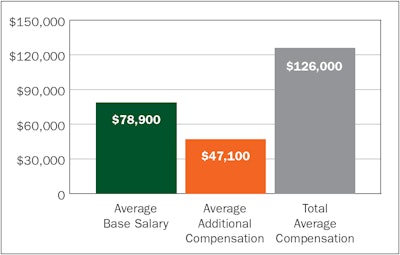
Money Talks
The issue of salary and compensation levels are currently sandwiched between two prevailing economic conditions: the trailing effects of the COVID-19 pandemic on business’ profits and payrolls, and modest inflation that some analysts think is more than just a temporary side effect of a rapidly recovering US economy.
As one of our many annual reports, we at Industrial Distribution use our Salary Report as a way to provide the industrial distribution market with a snapshot of current compensation rates and how the industry’s workforce feels about them — segmented by three tiers of job titles. Money certainly isn’t everything to distribution employees, but in an industry that has struggled to recruit and retain Millennials and now Gen-Z talent that is far more prone to job-hop than older generations, the almighty dollar is often an employer’s most valuable asset.
The US Bureau of Labor Statistics’ employment report issued July 2 showed that American workers are enjoying an upper hand in the job market, with average hourly wages up a solid 3.6 percent in June compared to a year earlier. Some economists have pointed to wage gains as an equal or bigger factor in inflation than rising commodity prices.
The 2021 ID Salary Report is based on a survey distributed via our digital channels of email, our daily e-newsletter and social media and conducted throughout June. The results are divided into three separate categories based on where respondents identified their specific job functions.
Though this is a long-standing survey, it was not conducted in 2019 during ID’s transition to a new publisher.
The following results are based on three separate sets of data from Executives (Owner, Chairman, CEO, CFO, CIO, COO, President or VP); Mid-Level (non-sales) Management (Product, Operations, Branch and/or Purchasing); and Sales Representative/Manager. This year’s split of more than 200 respondents came at 27 percent executives, 33 percent mid-level management and 40 percent sales rep or sales management. Overall, 85 percent of respondents were male, and the pool’s age breakdown was fairly evenly split at 22 percent under 40 years old; 21 percent at 41-50; 29 percent between 51-60; and 28 percent above 60.
Here in Part 3, we'll cover the results from Sales Representatives and Managers. The Executives results were posted here on Tuesday, and the results from Mid-Level Management were posted here on Wednesday.
Sales/Sales Management
Sales/sales management is reliably one of the most well-read content topics among our ID audience, with the pandemic naturally leading readers to content advising them on how to adapt and equip their sales teams for a virtual selling environment; the ongoing role of inside vs. outside sales; and how to best sell during times of downturn and market volatility. Since our 2020 Salary Survey, many professionals on the distribution sales front line were given a crash course in how to sell via Zoom meetings from their homes and help customers navigate numerous supply chain challenges in various markets.
Our sales/sales management respondent group is 86 percent male and rather young by industry standards, with 55 percent under 50 years old (33 percent under 40). This group has comparably the lowest amount of higher education, with 58 percent owning at least a college degree. Our sales/sales management respondents have been with their company for an average of 14.3 years and have been in their current role for an average of 8.3 years.

For those in this segment who reported a salary, their average was $78,900, with a median of $72,500 and a range of $24,000 to $228,000. Reported commissions/bonus pay averaged $47,100, making the average total pay package for this group $126,000. Perhaps due to the challenges of virtual selling and volatile market conditions amid the pandemic, 79% of this group say they feel the demands of their job have increased in the past year. That could also be why only 55% of this group say they feel fairly compensated.

Other sales/sales management segment notes:
Nearly 49% of this group is a supervisory role, with 43% of them overseeing 1-10 employees
This group has the largest amount of respondents staffed at large distributors, with 54% selling for firms with more than $100 million in annual sales (37.5% at firms with at least $500M)
As with our other two segments, the largest portion of this group — 40% — hails from distributors based in the US Midwest
40% consider the cost of living where they live to be higher than average
For those in this group who earn commission, 30% say it is consistent and comprises a large portion of their earnings, while 25% say it’s inconsistent and a small portion. 22% say their commission goals are attainable and motivating, while 12% say goals are unattainable and a source of stress.
40% of respondents say they’ve received a compensation increase in the last 12 months, and of those, 52% say it was a standard, merit-based pay raise. Of those who haven’t received a recent raise, less than 9% said they received a compensation decrease.
51% expect their salary and/or benefits to stay the same, while nearly 42% expect them to increase

Commentary
Comments from this group emphasized added responsibilities that haven’t equated with added commission — often the key factor in driving employees away from their employer. Here’s some of the commentary that our sales/sales management respondents shared regarding their compensation:
“Seems like base salary could be 10-15% higher per inquiries.”
“I suspect my company pays below average.”
“Corporate plays with cost to cut commissions.”
“Realistically too many different responsibilities due to staff shortages.”
“More has been added to the plate but not more compensation.”
“Way under industry standard.”
“My workload has increased exponentially but my pay has remained the same.”
“I am paid less than many others, no promotions, yet I produce some of the highest profits”
“They closed my local branch and want me to maintain the level of sales without the support of a branch.”
“I haven't had a salary or benefits evaluation meeting in 3 years.”
“New employees are starting out with higher pay; existing employees are not consistently rewarded.”
“Six figure jobs aren't what they used to be, inflation has outpaced income.”
ID’s Analysis
Like with our annual Survey of Distributor Operations, the results of this year’s Salary Survey were noticeably impacted by pandemic-driven economic conditions for a second-straight time. However, the conditions are rather opposite: our 2020 Salary Survey was conducted in-between the first and second wave of the pandemic in North America, whereas this year’s reached respondents as the continent had largely put the pandemic behind it and the US economy was well into a summer recovery roar.
Last summer, many publicly-traded industrial distributors and manufacturers shared company plans to make pay cuts company-wide, with some taking a top-down approach where executives took the largest reductions. At the time, pay raises were also largely frozen as a means of financially navigating the pandemic’s impacts. This summer and fall, it will be very interesting to see if these same firms say anything about plans to reinstate any of that lost employee compensation.
And while most distributors are doing much better today than they were a year ago, one respondent’s comment illustrates that not all employees are feeling the recovery. This is especially true for those small distributors where employees often wear many hats. Says one sales/sales management respondent: “Pay is solely on sales, but do not have the allotted time to make necessary sales. In between being a warehouse person, a delivery driver, inside salesperson and order expediter, I am not driving new business.” Such a comment helps keep things in perspective as the industry resumes conducting in-person business and attending trade shows again. A lot of those who make this industry work could still use some help.























